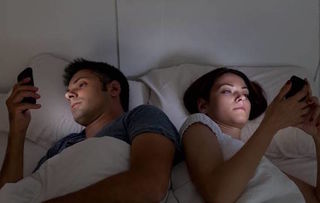Media
Why Your Smartphone Is Destroying Your Life
And what you can do about it.
Posted January 30, 2018 Reviewed by Matt Huston

Today I’m psyched to address an issue that plagues us all. It excites me so much, it even rivals karaoke on my personal passion scale.
But first, a question for you: Would you like to be mentally sharper and more empathic in the moment? The majority of you would probably say yes. What if I told you you could improve these things for free, with just one small act? Now you’re perhaps both intrigued and suspicious.
I promise, it’s not a trick. You need only do one thing: disconnect from your smartphone (not just set it down, but REALLY disconnect). Less excited about that prospect? Here’s are some findings to entice you:
New research suggests that our memory capacity and ability to process data may improve when our smartphone is completely out of sight — in a bag or another room altogether. Think that turning it on silent, face down, will remedy the problem? Nope. The mere sight of the phone might diminish your cognitive resources.
Additionally, a visible phone in a social setting can measurably decrease the depth of the interaction, creating more superficial social exchanges.
This is huge: scrolling obsessively through social media isn’t the only smartphone battle you need to wage. Just seeing the overpriced device plays games with your brain (and your brain is losing, for the record).
Here’s another disturbing stat: This tally seems to increase daily, but by one study’s count, the typical smartphone user interacts with their phone around 85 times per day. And this often includes middle-of-the-night checks for work emails and new “likes.”
We’re so obsessed that there’s now a word to describe a fear of being without your phone: “Nomophobia.”
So what should we do about this smartphone tsunami?
There are two paths to improving this situation. The first involves a transformation of the technology and the platforms that suck us into its incessant use. Fortunately, some companies are recognizing the habit-forming nature of their platforms and at least starting to pay lip service to designing for “good.” (If you think the nature of these designs is “random,” you are greatly underestimating the monetary value of your obsessive attention — and the desire of companies to capitalize on knowing how to attract and maintain that attention.)
And while the knowledge that too much technology can have negative effects on our lives is not new, we are just now seeing the very technology companies that created these irresistible devices and platforms start to address the problem.
Recently, investors asked Apple to figure out how to help parents limit their children’s use of iPhones and iPads, citing concerns over “long-term health.” Former Facebook employees are speaking out about the power of their platform and their concerns about how it’s affecting their lives and the lives of their children. And just this month, Mark Zuckerberg announced his intention to turn the social network into a force for good, in part by revamping its news feed algorithm to prioritize interactions with friends and family over articles and videos (stuff that induces more passive scrolling).
This change was sparked by new data indicating that using Facebook often — shocker! — makes people feel crappy, but that meaningful interactions and shared memories on the platform foster well-being. I’m sure the data deserve more nuanced analysis, and while making Facebook more like Instagram by minimizing links and amping up the visual quotient may diminish fake news links, it definitely isn’t a panacea for measured use and general well-being. (i.e. Find yourself “reminiscing” about and virtually stalking that ex you’re still obsessing over? Where does that fall on the social media well-being scale?)
How this new Silicon Valley call-to-action plays out remains to be seen. And debating just what sort of “responsibility” these companies have when it comes to designing and programming for optimal health and happiness is worthy of a whole book. The best we can hope for is they figure out how to monetize our healthy behaviors as profitably as our unhealthy ones.
And in the meantime, I suggest you pursue the other solution:
Create boundaries. Implement rules.
First, let me be clear: Taking back control need NOT include tossing your smartphone in the ocean or having a smartphone destruction party (though secretly, I really want to throw one of those). Rather, it starts with acknowledging the reality of the incriminating data against your current use patterns and changing your habits and practices through actionable steps and enforced rules.
Feels impossible? No one’s telling you to stop using technology altogether, or to get off all social media or stop using the millions of useful tools for increased functionality, efficiency, and knowledge now available at your fingertips. A healthier, happier relationship with technology is about a peaceful, rule-bound co-existence, not a complete rebuff. And if you can truly say that you are not addicted to your phone, that probably means you are my mother and have yet to respond to my text from last week. (Hi Mom, you can stop reading now.)
For those of you who did not give birth to me, here are the ways I have personally designed a healthier relationship with my smartphone. I’m not bragging about my practices and I’m no technology saint. This is a work in progress, I definitely slip up and spiral into scrolling hell, and these rules and strategies are constantly evolving. But I DO notice a difference as a result of my implementation of each of them, and so I think they’re worth sharing:
- Delete select social media apps: I recently decided to delete the Instagram and Facebook apps from my phone. I now only use Facebook from my computer — something I rarely do anyway. (I do, however, have Facebook messenger on my phone, as it is a popular texting app for my international friends; though I personally prefer to use iMessage or Whatsapp, as I don’t want Facebook to have a record of my conversations, which they can convert to data and use to strategically market to me.) As for Instagram, I now must redownload it every time I want to post on Instagram, which averages a couple of times per week. That may seem like an annoyance for some of you, so I’m not saying it’s for everyone. But I found myself developing an unsavory habit of killing dead time in the app, scrolling, looking people up, inevitably comparing, judging… It didn’t feel good. So now I redownload and log on to post content and do a brief catch up, then delete again. It feels cleaner and healthier and I already mentally feel the difference.
I did, however, keep Twitter on my phone. I appreciate the articles and humor of the accounts I follow, am never tempted to stalk anyone on there, and don’t feel dirty after using it. Twitter is a “safe” app for me. I know that’s not the case for everyone, so I’ll let you decided which social media apps work for you and which should be deleted (if only to redownload regularly), and then develop your own boundaries and rules about engagement with them. But chances are, you need some social media app rules.
- Turn off notifications: If deleting some apps is too extreme for you, at the very least turn off non-essential notifications: All social media notifications, news notifications, games, etc. Go into your settings and turn off pings from most of the apps on there. (I keep my calendar and bank alerts on, as well as any messaging, ride sharing, or delivery apps.) I also recommend setting your phone email app to refresh manually — not automatically. The goal here is that you should have to come to these things; they shouldn’t seek you out.
- Put away your phone when socializing: This is a big one. I’ve long had a rule that my phone stays in my bag and out of sight when I’m with other people. The only exception to this is if someone is coming to meet us and I need to keep it out temporarily to coordinate (and once they arrive or the coordination is complete, the phone goes away). Sometimes the phone will come out to show a person a photograph or quickly look up a stat, but then it goes back to its place in my bag. And as we already established, merely having it facedown on the table is not enough. It needs to be out of sight. And if it’s in a pocket or bag near me, I like to turn the vibration off and put it fully on silent.
For the record, I don’t officially require people I’m with to do the same, BUT I greatly appreciate it when they do, am more likely to make time to hang out again, and definitely notice the difference in the depth of our connection and communication when their phone is put away vs. sitting in front of us, ready to demand their attention at any moment. If you have kids and feel you must always be on call, enable the “Repeat Calls” feature when your phone is on “Do not disturb” and get the best of both worlds (and at least keep it out of sight).
I promise, no one is so important that they must always be available to any and all phone notifications while with other people. I’ve said this before and will say it again: Your full presence is the greatest gift you can give someone in the age of technology and distraction. Time for some generosity. (And while it might seem like a sacrifice on your part, you will reap the rewards as well. Win/win.)
- Turn your phone off at night and place it out of sight: For years, I’ve been turning my phone fully off while I sleep, and on the nights when I don’t turn it off (usually when I need some sort of backup alarm clock), I don’t sleep nearly as well. Turning my phone off signals to my brain that I’m off-duty.
I recommend getting an old school alarm clock — mine cost less than $10 on Amazon, folds up super tiny and travels everywhere with me, and lasts for years. If you MUST use your smartphone as an alarm clock (I’m trying to imagine why that would be, but I’m sure some people will tell me it’s a necessity) or if you are once again in the “I have kids, I have to be available” category, then again enlist the “repeat calls” feature from above or only allow certain numbers to come through. And if possible, put it on airplane mode (‘do not disturb’ will still deliver messages and notifications and you’ll be tempted to steal a glance if you wake up at night).
Regardless of which option you choose, place the phone across the room from your bed — out of sight, out of mind, and safely out of reach.
- Download a book app: I downloaded the Kindle app to my phone last year, so now when I find myself waiting or with a few minutes of downtime, I can open up the Kindle app (which syncs with my iPad or Kindle reader to keep my place) and can pick up reading whatever book I’m currently into. It transforms the downtime to luxurious reading time, while avoiding any of the scattered app-hopping and mindless scrolling behaviors I am inclined to engage in without it.
The other alternative here is to always carry physical reading material with you — you know, like an actual book or magazine. And pull that out instead of your phone when you have a few minutes to kill. But let’s face it: even if you still love the paper material (which I do), you don’t ALWAYS have it with you. The book app is a good backup.
- Change your phone from color to grayscale: This is one I haven’t yet tried, but it is a worthy experiment, especially for those of you who don’t need to publicly share and manage photos as part of your profession. The idea is that color manipulates our decisions, grabbing our attention and telling us what’s important. Greyscale, by contrast, facilitates more “controlled attention.” It’s not a simple task to change this setting, at least in the iPhone (of course), but if you are game for the challenge, here are some tips to successfully executing it on your iPhone or Android. Bonus points if you also take away the sound.
Digital happiness is a topic I’ve been researching, teaching, speaking, writing, and coaching on for the better part of the last decade. It hasn’t gotten simpler or easier with time. Quite the opposite. But as more data pours in, it’s my hope that people will take back control and design the lives they want for themselves by consciously pushing back on the destructive habits and mindsets that erode our quality of life and ability to connect.
Your phone should be a conscious choice. A positive tool — something useful in your life, not something that detracts from it. There is life beyond the phone, but experiencing its richness requires mindfulness and discipline. So whether your goal is to be more meaningfully connected, to emit more empathy, or to be smarter, the data is in: Silence and put away your phone.
What are your smartphone rules? What boundaries do you have and which do you struggle with? What stories do you have of times you’ve said no to the phone? Please share them in the comments and pass this along to others in your life — who will likely read it on their smartphones.




